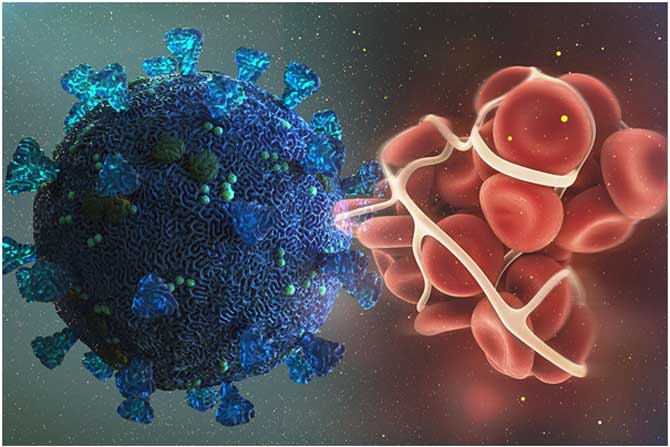The lockdown has impaired the movement of people across the country. This has led to higher incidences of DVT

Dr. Sekhar
Thrombosis, also referred to formation of a blood clot (thrombus) in a blood vessel, is an often undiagnosed and untreated condition with severe repercussions. With about fifteen different types of thrombosis affecting different parts of the body, the most asymptomatic is Deep Vein Thrombosis (DVT). To understand why DVT is so problematic, one must first understand what deep veins are. Deep veins are much farther away from the skin than other veins. When a clot is formed in one of the deep veins, if untreated, it could potentially travel through the circulatory system and get settled in other parts of the body (also known as thromboembolism).
ADVERTISEMENT
There are three major factors that can lead to clot formation: restricted or limited movement; damaged blood vessels, possibly caused by certain surgeries or pressure in the blood vessels; and disturbance in the pattern of the blood flow, which leads to stagnation of blood in the arteries or veins.
The lockdown has impaired the movement of people across the country. This has led to higher incidences of DVT. However, the fear of getting infected with the coronavirus along with the increasing burden of the COVID cases on the healthcare system has disrupted non-COVID treatment. Dr. R Sekhar (MS, FRCSEd, FRCSGlasg, FVSI) Consultant - Vascular and Endovascular Services, Kokilaben Hospital, Mumbai talks about the hesitancy behind seeking treatment says, "People either feel that the hospitals are currently treating COVID-19 patients only or they fear they might contract the infection if they come to hospital. They do not realise that a delayed diagnosis of DVT is more lethal than COVID. In fact, most would not realise that thrombosis itself could be a means of manifestation of the infection."
Having said that, Dr Sekhar also believes that as distressing and dangerous as the pandemic is, it should not be a reason to wish away potentially lethal diseases such as DVT. He added, "The incidence of thrombotic events is on the rise. It is prudent to be sensible and understand that hospitals have protocols in place for patient safety. Patients have more to fear from delayed diagnosis of vascular diseases than of the consequences of contracting COVID. While a vast majority of coronavirus infected patients recover, patients with delayed diagnosis of thrombotic events in the vascular system end up losing a limb or life."

Having said that, management of Deep Vein Thrombosis is crucial as well.
- Patients must ensure that they stay well hydrated
- Avoid alcohol as it causes dehydration
- Daily exercise is a must as it ensures optimal functioning of the circulatory system. This helps preventing stagnation of blood, thereby avoiding the formation of clots.
Case Study 1:
Harish Mishra* (name changed), aged 56, had low-grade fever and a swollen leg for a week. Owing to the disruption of non-COVID healthcare services and the fear of contacting the infection, Harish chose to opt for a local massage and self-medicated with painkillers and antibiotics. However, his condition steadily deteriorated. Harish was later diagnosed with massive Deep Vein Thrombosis (DVT), with a large clot ready to travel to the lungs. He also tested positive for COVID, with thrombosis being a known complication of the viral infection. Timely response, however, prevented fatal complications.
Case Study 2:
In contrast, Stanley Lawrence* (name changed), a young sailor aged 22 noticed swelling in his legs during the lockdown. A self-confessed and enthusiastic gym-goer, his water intake was very low. On observing the swelling, he rushed to hospital right away got cured of a potentially lethal DVT. Early diagnosis and effective management aided his recovery and he is back sailing now.
With recent advances in medicines, thrombosis can be effectively managed if there is sufficient awareness among the patients. If swelling in the leg or ankle is observed, along with low-grade fever and breathlessness, patients must seek professional help immediately. They must avoid self-diagnosis and self-medication, especially in times of the Pandemic. In addition, positive lifestyle changes and preventative treatment with anticoagulants can also help make a tremendous difference in the patients' lives.
Catch up on all the latest Crime, National, International and Hatke news here. Also download the new mid- day Android and iOS apps to get latest updates.
Mid-Day is now on Telegram. Click here to join our channel (@middayinfomedialtd) and stay updated with the latest news
This story has been sourced from a third party syndicated feed, agencies. Mid-day accepts no responsibility or liability for its dependability, trustworthiness, reliability and data of the text. Mid-day management/mid-day.com reserves the sole right to alter, delete or remove (without notice) the content in its absolute discretion for any reason whatsoever.
 Subscribe today by clicking the link and stay updated with the latest news!" Click here!
Subscribe today by clicking the link and stay updated with the latest news!" Click here!






